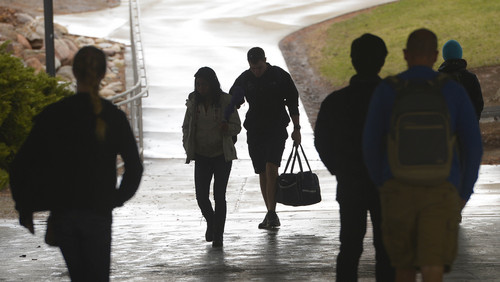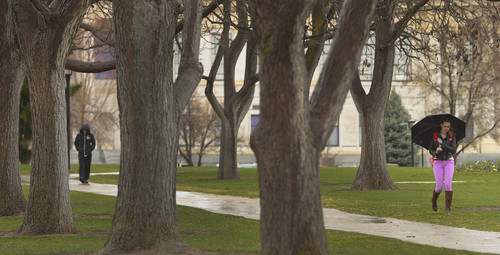This is an archived article that was published on sltrib.com in 2014, and information in the article may be outdated. It is provided only for personal research purposes and may not be reprinted.
Utah's college enrollment continued to drop this semester, particularly among women, a trend attributed to lowered age requirements for Mormon missionaries. The dip raises concerns in a state with the country's largest educational achievement gap between men and women.
"Will they return and finish college?" asked October 2012 announcement">Susan Madsen, founder of the Utah Women and Education Initiative. "That's the worry now."
Head count enrollment figures released by the Utah System of Higher Education this week show women are down 4.2 percent and men have decreased 3.8 percent. This is the third semester in a row the number of college students has declined after the October 2012 announcement on the missionary changes from the Salt Lake City-based Church of Jesus Christ of Latter-day Saints.
"It's a little bit of a drop but not a surprise," and lower than some projections, said Commissioner for Higher Education Dave Buhler.
An improving economy drawing people into the workforce also is a factor.
All able LDS men are expected to serve a mission, and now that they can leave at age 18 rather than 19, many go right out of high school rather than enrolling in a semester or a year of college before. That change could actually improve Utah's six-year graduation rates — which a recent report placed at the lowest in the country — since fewer male students will be taking a two-year break in their studies. Female students are another story.
"The ones we worry about are the young women going at 19," said Buhler.
Girls now can serve a mission at age 19 rather than 21, a switch that has already given a tremendous boost to the number of "sister missionaries." Historically, the proselytizing force was less than a fifth female. Many women married returned male missionaries and started families before they reached the required age.
But since the age change, about half the explosive growth in mission applications have come from women.
"It's become more of an opportunity for people. So many women view it as something you do if you don't have a lot of options going on, where as now people are looking at it more as a way to serve," said Candice Backus, a 21-year-old Utah Valley University student from Herriman who's planning to depart on a mission in the spring.
When it comes to academics, though, the break has the potential to exacerbate a troubling trend: While Utah women start college at about the same rates as others around the country, fewer finish four-year degrees.
Many women drop out to get married and rear a family or aim for associate degrees instead, Madsen said, contributing factors in the gender pay gap in Utah, which is one of the largest in the country.
"Many women aspire to go to college but not necessarily to graduate," said Madsen. "They're thinking they're going to get married and it'll be great and hopefully it will for them, but statistics show it doesn't always happen that way."
And returning from a mission at age 21 or 22 will put women fairly close to Utah's average marriage age of 24 , according to the U.S. Census — the lowest in the country.
For many men, though, the hard work, study time and long days required on missions have been effective preparation for a rigorous college experience, Madsen said, and missions could have the same effect on women.
"You learn how to study," she said, "you learn how to learn."
Backus is a political science major who has served two internships at the Utah Capitol and one in Washington, D.C., and plans to go to law school.
She said she has six friends on missions right now.
"All of my friends who I've talked to, they're all making plans to go back to school," said Backus. "I think when women return, they'll be focused, not just on getting married but on getting a serious education."
Twitter: @lwhitehurst





